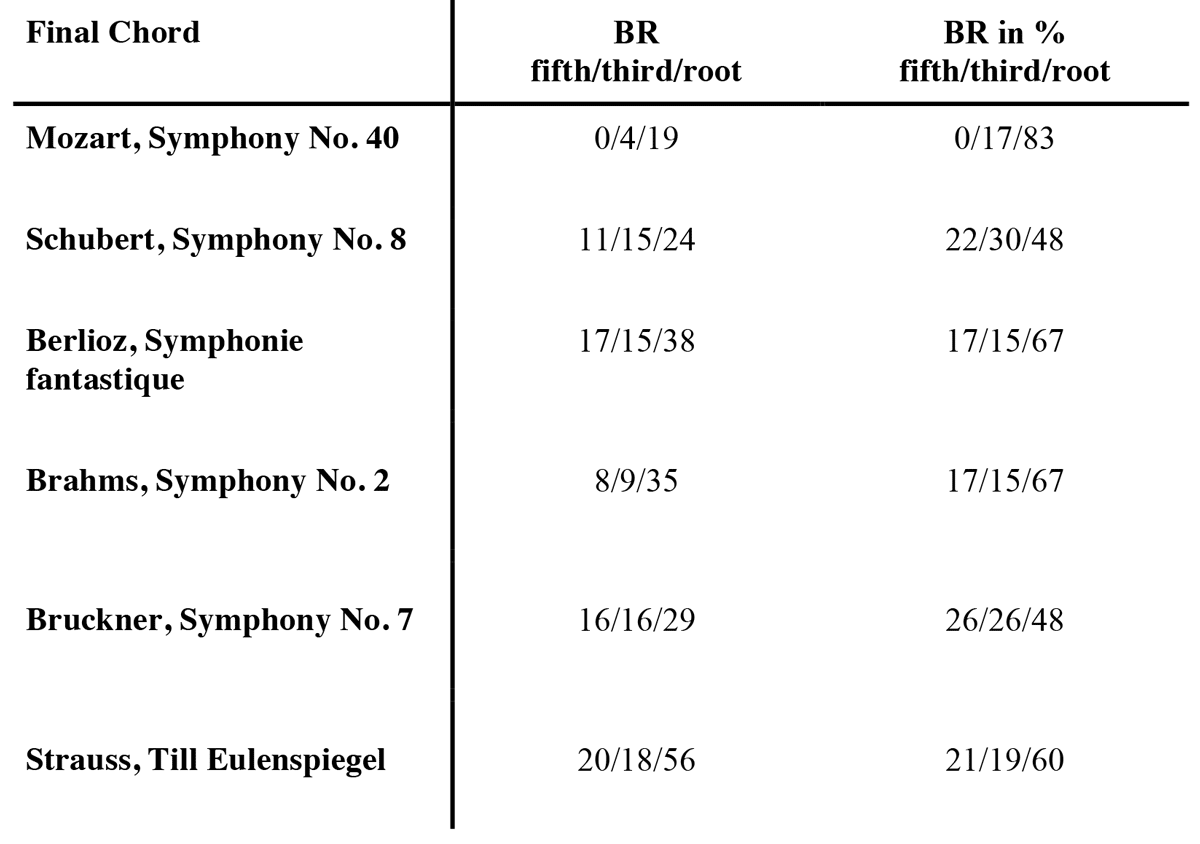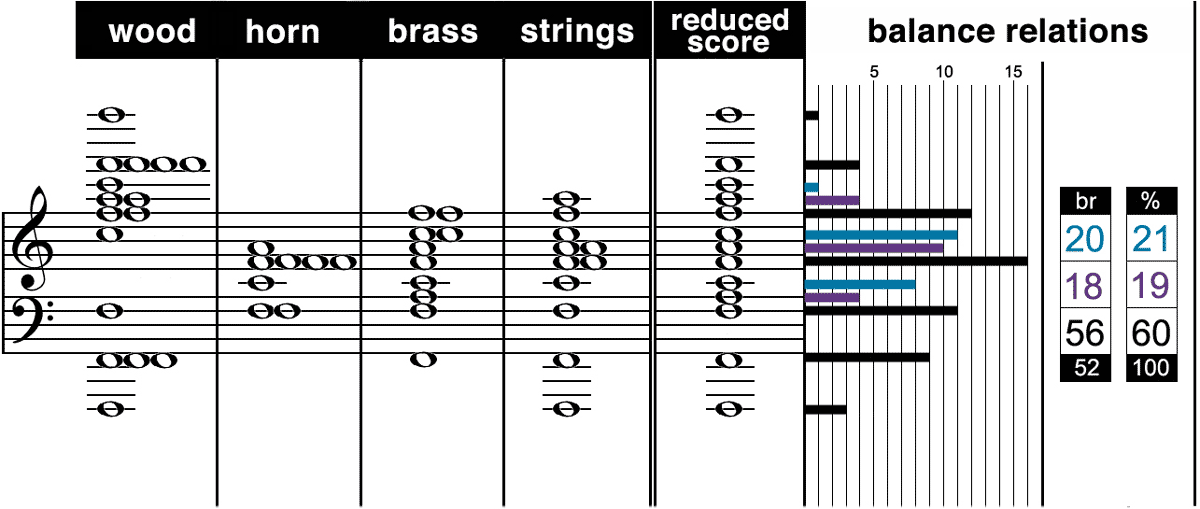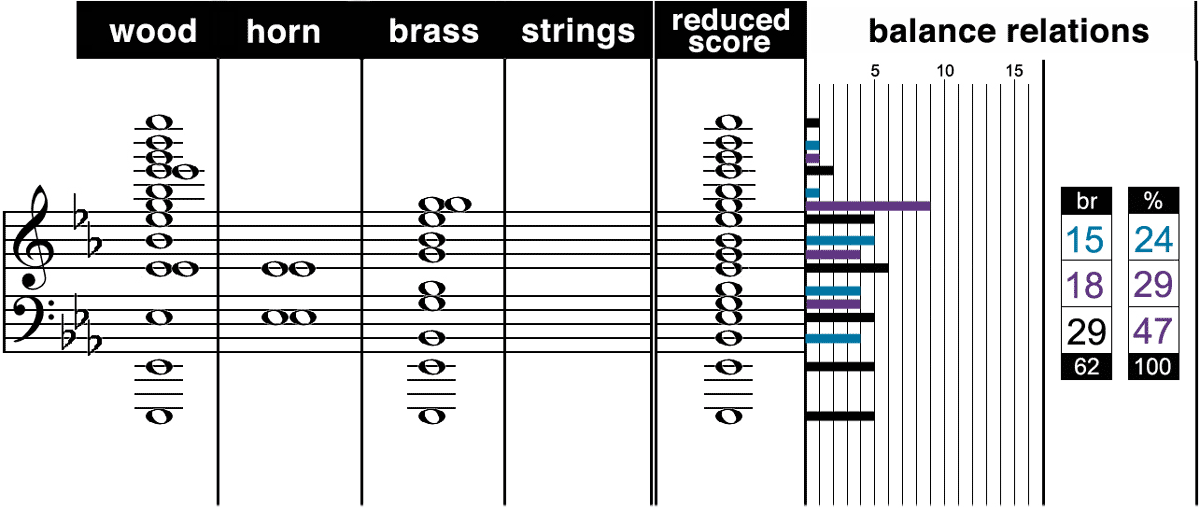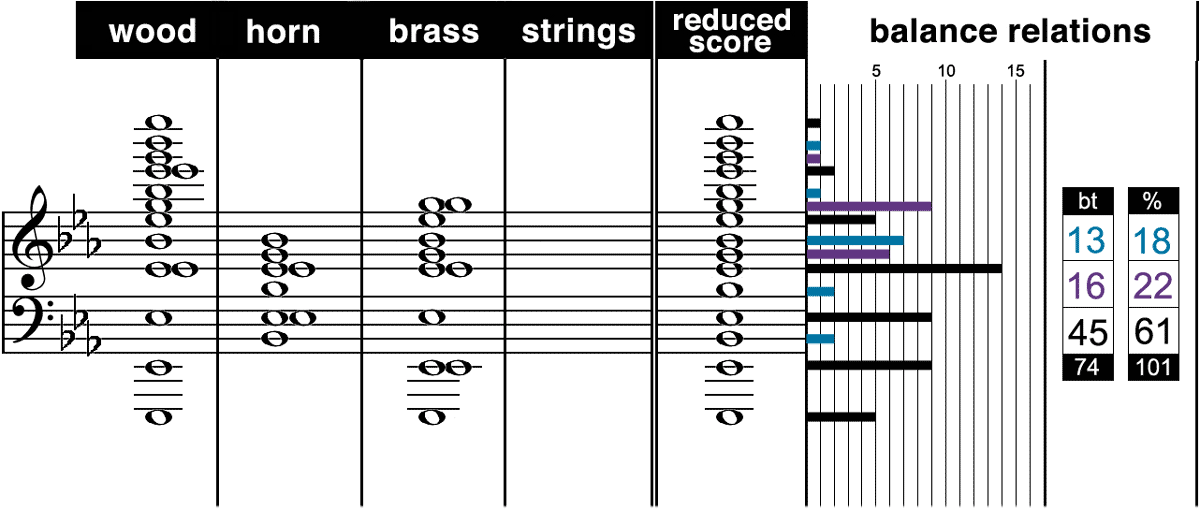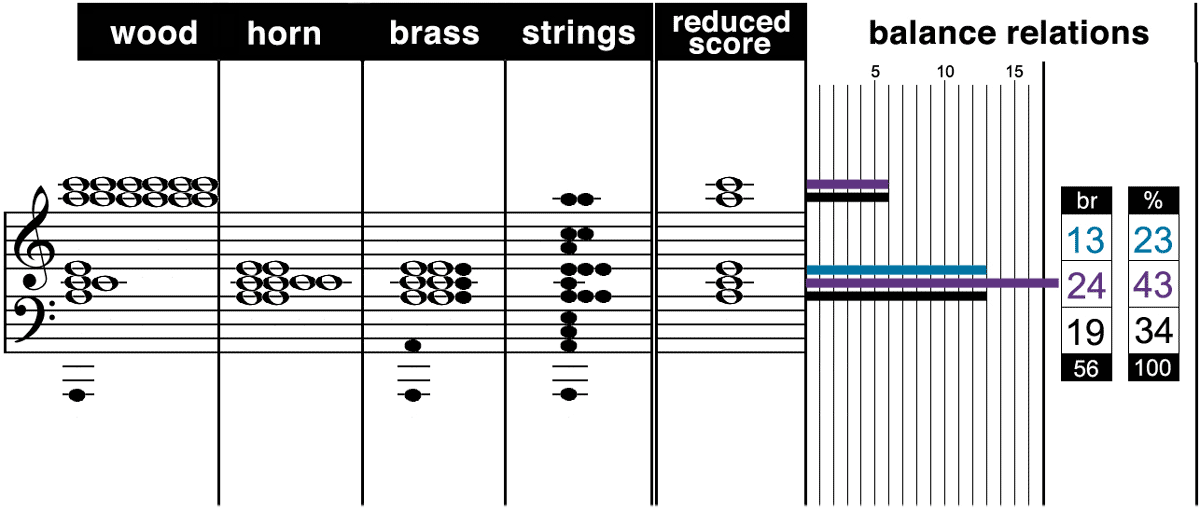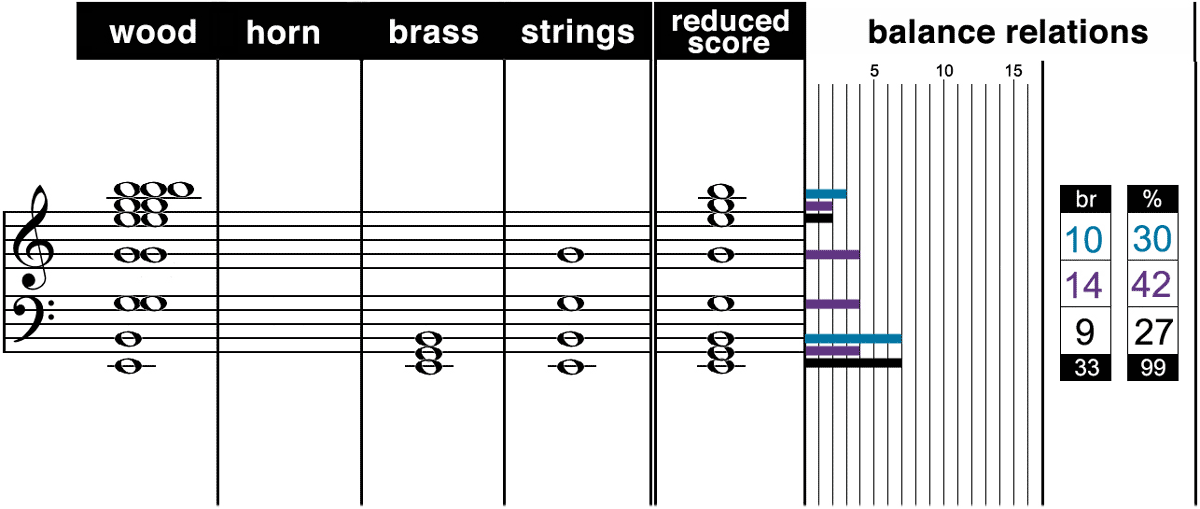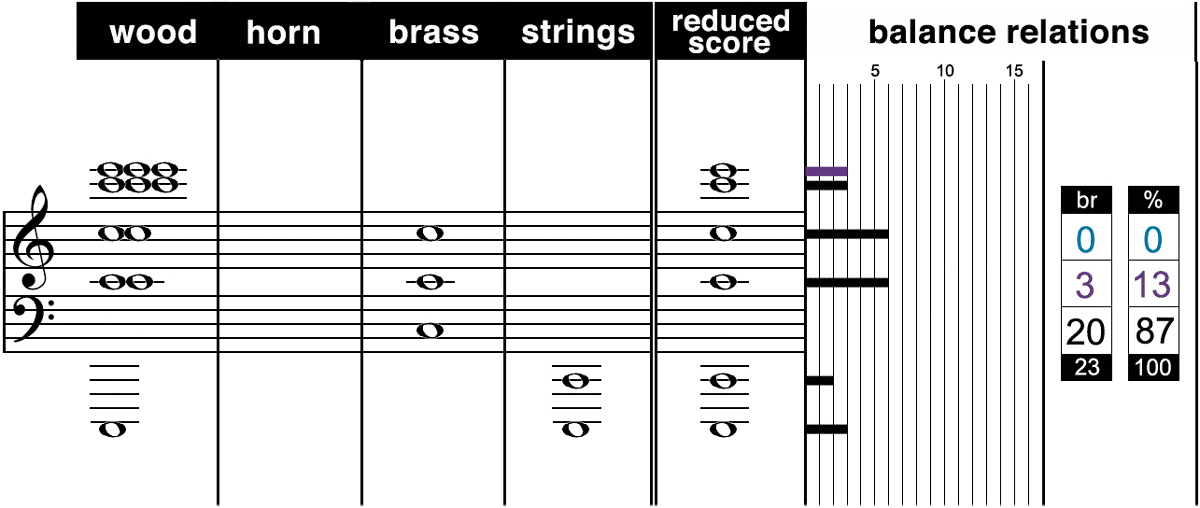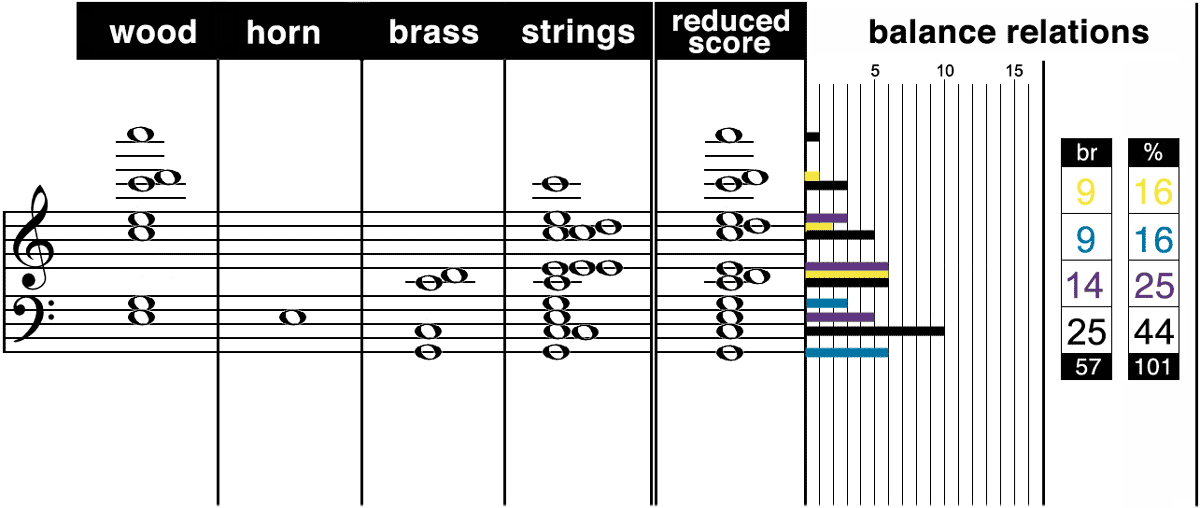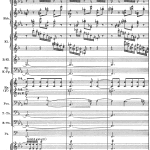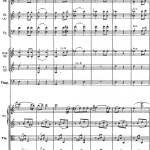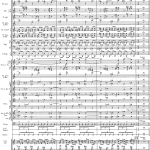Balance between instruments, groups, segments and voices is an immense topic, but appears in its purest, most overt form in connection with orchestrating a well-balanced chord.
In traditional four-part writing, the basic rule is to double the root of a triad in root-position, raising the following question: does a traditionally orchestrated triad in root-position entail an equivalent doubling? Well, without some consensus on the general sound power relationships between instruments, the question cannot really be answered at all, while the use of balance ratio (BR) allows us to answer it in the affirmative, simply by means of counting. In principle, BR can provide an overview of the balance of any chord or harmony. Naturally, the balance between instruments is less prominent in chords of very short duration. The method is particularly suited to sustained chords at a high dynamic level, notably final chords, not least because BR – as argued above – is at its most reliable in forte. How to rate the power of a kettledrum in terms of chordal balance is a matter of opinion. In the present context, we have defined it as a percussive element, and chosen to omit it – with its nearly unlimited dynamic range, a specific BR cannot be assigned to the kettledrum. Furthermore, the kettledrum will typically mark the root note in classical or romantic music, and, if included, simply represents a reinforcement of the root.
Chords played by a harp, piano, or similar instrument, are not included here, unless they participate in creating a deliberately unusual balance. As to divisi in the strings, every single note will count as “2”. For double stops, each sustained note is counted.
An analysis of the final chord in the last movement of Brahms’ 2nd symphony shows a BR of 9/8/35 for the fifth, third and root of the triad (this order will be maintained from here on). Converted to percent, and rounded off to the nearest whole number, this represents a relative sound power of 17/15/67. Thus, 67% of the sound power is allocated to the root of the triad.
Figure 129 · Brahms, Symphony No. 2, final chord
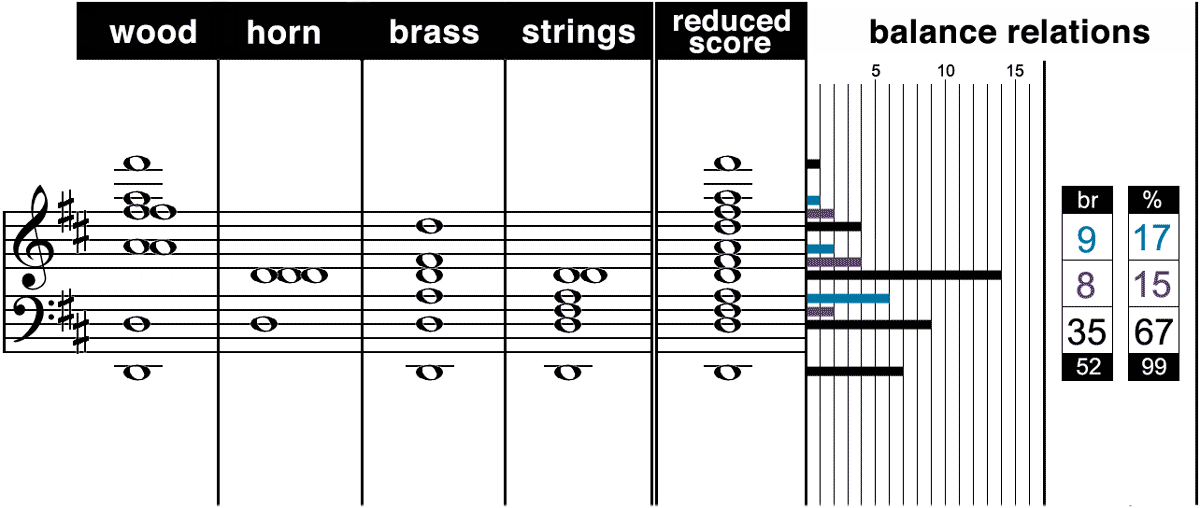 Audio 129a · Klöber/Deutsch-Niederländische KammerPhilharmonie
Audio 129a · Klöber/Deutsch-Niederländische KammerPhilharmonie
Audio 129b · Barenboim/Chicago Symphony Orchestra
By way of comparison, the final chords in the last movement of Brahms’ 1st and 4th symphony have a BR of 11/11/29 (in percent: 22/22/57) and 4/12/37 (8/23/70), respectively. The table below shows a similar predominance of the root in final chords from the classic/romantic symphonic repertoire (all examples taken from the last movement).
The physiology of the human ear allows for very precise perception of pitch in the center of the hearing range, gradually weakening towards the high and low end of the register, a phenomenon many cello players may regret: while the violin’s high register is located in an area in which the ear’s sensitivity to precise intonation is somewhat weakened, the high register of a cello lies right in the middle of the hearing range, so that even slight intonation problems become noticeable. Usually, the most powerful overtones in the sound spectrum of a very low note are located in this middle range and may considerably influence the balance and timbre of a chord. Therefore, the traditional orchestration of a triad in root position avoids letting powerful overtones from low bass notes interfere dissonantly with the three notes of the triad in the middle register. Consequently, the low register is dominated by the consonant octave, followed by the fifth, while the third with its dissonant overtones is present only when highly unusual triadic chords are called for. In fact, all chords, tonal or atonal, triadic or not, tend to be structured in such a way that the largest intervals are placed in the bass register, preventing narrow and dissonant overtones from interfering with material in the central hearing range. In very general terms, the predominant weight of a balanced orchestral chord is most frequently assigned to this middle area (disregarding occasional powerful root notes in the bass)[1].
Figure 130 · Strauss, Till Eulenspiegel, final chord
Audio 130 · Blomstedt/San Francisco Symphonie Orchestra
The final chord of Strauss’ Ein Heldenleben, scored without use of the strings, once again shows the reinforcement of the root note. The attack of the chord is followed by a diminuendo to piano in the final bar, continuing to fade molto diminuendo to the end. Here Strauss reorganizes the disposition of the notes in different registers, but, rather than removing instruments to underpin the diminuendo, he adds four horns, while a trumpet and three trombones are moved from the fifth/third to the root. This serves to reinforce the root and the chord’s focal point in the middle of the hearing range.
Figure 131 · Strauss, Ein Heldenleben, final chord (ff)
Figure 132 · Strauss, Ein Heldenleben, final chord (p molto dim)
Audio 132 · Rattle/Berlin Philharmonic Orchestra [missing]
Strauss’ Tod und Verklärung ends with a well-balanced C major chord scattered evenly over the entire register. Because the score calls for pianissimo,the BR only provides an indication, but the root “doubling” is still evident, as is the emphasis on the middle of the hearing range.
Figure 133, Strauss, Tod und Verklärung, final chord
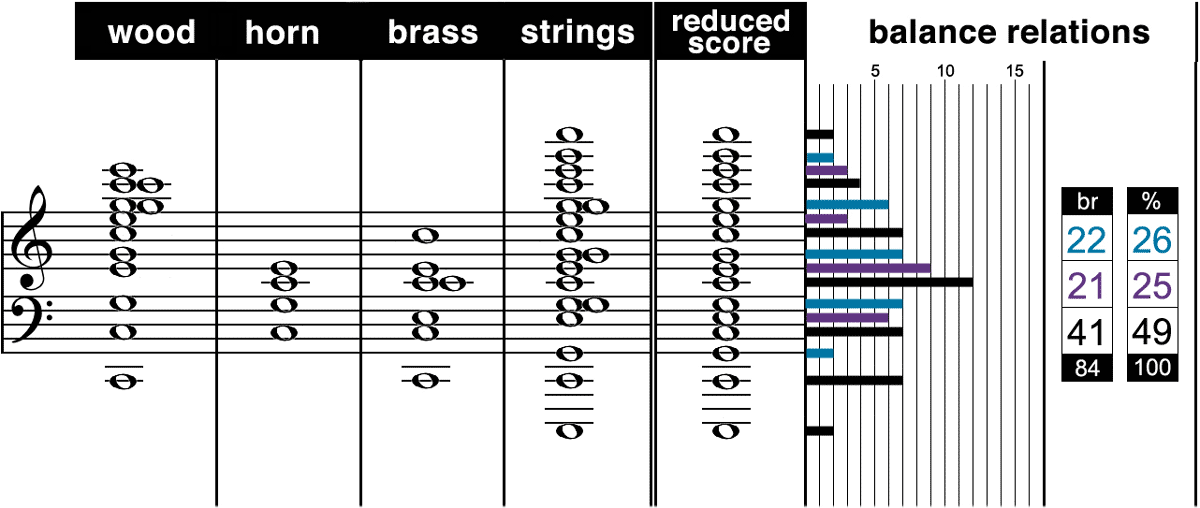 Audio 133a · Gatti/Royal Concertgebouw Orchestra
Audio 133a · Gatti/Royal Concertgebouw Orchestra
Audio 133b · Zinman/Zurich Tonhalle Orchestra
Used discreetly, and possibly with a bit of cautiousness, Rimsky-Korsakov’s balance ratios provide a tool for both analyzing and constructing chords and other balance issues with specific properties.
In Gustav Mahler’s 6th Symphony – a work sometimes described as a “battle between minor and major” – the minor third ends up victorious, a fact that Mahler highlights by balancing the final A minor chord 13/24/19, i.e. with a strong emphasis – a “doubling” – of the third. The short attack in the strings, low woodwinds and brass (in black note heads below) has not been included in the BR, but with its traditional “root doubling,” it highlights the unusual balance of the sustained chord that follows.
Figure 134 · Mahler, Symphony No. 6, final chord
Audio 134 · Bernstein/Vienna Philharmonic
The very unusual E minor staccato chord that opens Stravinsky’s Symphony of Psalms and the C major chord that ends the work are further examples of unusual doublings and dispositions in the different registers (harp, piano and choir are not included in the analysis, figure 135).
Figure 135 · Stravinsky, Symphony of Psalms, opening chord
Audio 135a · Solti/Chicago Symphony Orchestra
Audio 135b · Muti/La Scala Choir and Orchestra
Figure 136 · Stravinsky, Symphony of Psalms, final chord
Audio 136a · Solti/Chicago Symphony Orchestra
Audio 136b · Muti/La Scala Choir and Orchestra
The chords in figs. 107–112 revealed a fairly equal distribution among the various octaves in woodwinds, horns, brass and strings (although the range of brass instruments in the high register is naturally limited). In the example above, however, the various orchestral groups gravitate towards separate registers, something frequently seen in 20th century orchestration. Instruments can be scattered freely over the entire range of a chord, they may overlap in various ways or be organized in individual “blocks,” giving them a unique sonority and character.
In this way, orchestration can underline the specific properties of many types of chords. The final chord of “Galop”from Stravinsky’s Suite No. 2 is a C major chord with an added D, and – very unusually – with the fifth in the bass (because of the chord’s short duration, each note in the strings’ chords has been included).
Figure 137 · Stravinsky, Suite No. 2, “Galop,” final chord
Audio 137 · Marriner/Academy Of St. Martin In The Fields
The way in which we perceive the harmonic function of a more compound or complex chord is not only a matter of context, balance and register disposition. The dissonant, extremely expressive chord that concludes the introduction to Strauss’ Don Quixote (just prior to the entrance of the solo cello) may be interpreted as an A major dominant ninth chord with lowered fifth (which is how the balance between the five pitches has been interpreted below). Yet it is obvious that the dramatic effect has been considerably reinforced by emphasizing the sharply dissonant note Bb. The chord may also be analyzed as two triads a tritone apart, a harmonic structure that represents a fascinating chapter in the history of music around 1900.
Figure 138 · Strauss, Don Quixote, m. 120
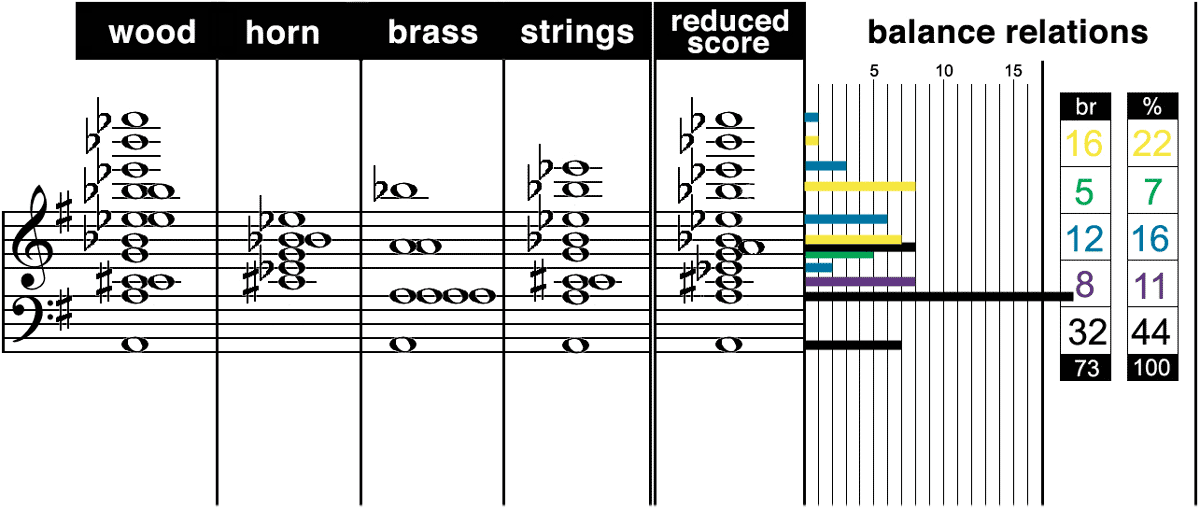 Audio 138 · Sawallisch/NHK Symphony
Audio 138 · Sawallisch/NHK Symphony
The degree to which a dissonance is experienced as “hard” depends very much on the placement of the individual notes of the chord – the further apart two notes are placed from each other in terms of register, the less intense or obtrusive the dissonance between them will be perceived. Another important factor is the overtone spectrum of the instruments involved – powerful, high-pitched overtones in the sound spectrum produce more piercing dissonances. The interval of a minor second seems far less harsh when played by two low flutes than by two low oboes.
The examples above were inevitably somewhat randomly chosen and should above all be regarded as an invitation to delve more deeply into the orchestral literature. Whenever possible, the full score should be used for study, as the above examples convey little about the actual sound of the chords themselves. When chords are marked with crescendo or diminuendo, the dynamic qualities of the individual instruments involved should be considered as well; a low oboe has very limited room for diminuendo, whereas a string instrument or a low clarinet has almost no limitations in this respect.
Finally, BR is an important practical tool when it comes to assessing the relative importance of different segments. Here the situation is more complicated because our perception of what is important is not merely a matter of sound power. Regardless of volume, most melodic segments will naturally be perceived to be more important than an accompaniment, and a BR comparison of foreground vs. background will not always reveal the true relationship between segments. And even when segments have comparable functions, the balance ratio must be included as part of an overall assessment.
Figure 139 · Strauss, Ein Heldenleben, number 71, m. 4
In this powerful passage from Strauss’ Ein Heldenleben, an inexperienced score reader may well find his or her attention drawn to the many fast notes in the woodwinds. Balance analysis shows, however, that this segment only merits a BR of 6–7, since the entire woodwind section does not play together at the same time. The main element is the melody played by three trombones and supported by cellos and basses, with a BR of 16. Although the sustained chord in horns, brass and strings is relatively prominent, it clearly acts as a background (violins/violas are, in fact, only marked forte).
When using BR as a tool for assessing relative importance, it is essential to take into account the overall context, as evidenced by the example below.
Figure 140 · Beethoven, Symphony No. 7, 2nd movement, m. 75
The melody in woodwinds and horns (main subject) has a BR of 12, the accompaniment a BR of 8 (in addition to trumpet support on the first beat), whereas the cantabile melody in the 1st violins only scores a BR of 2. But due to the persistent, nearly immobile ostinato of the main subject and the accompanimental function of the other strings, the counter-melody in the 1st violins emerges clearly and puts any schoolmasterly use of balance ratios to shame.
In very complex passages, like the one below from Stravinsky’s Le sacre, even experienced score readers are unlikely to identify the main segments at first sight. In order to gain an overall understanding of the passage, a segment analysis supported by BR is a simple necessity.
Figure 141 · Stravinsky, Le sacre du printemps, 3 m. before number 71
The difficulty of grasping 30 staves at once, often with two or three different parts each, requires no comment. In any tutti passage in which brass instruments play an important role, the attention must first be directed towards them. With a BR of 30, the ostinato in the trumpets (including a piccolo trumpet doubled by piccolo flute and piccolo clarinet) and trombones proves to be very forceful indeed. But the complementary rhythm of this “split unison” renders the segment considerably less prominent than one would expect. The continuous melodic line in tenor and bass tubas in the middle of the hearing range (BR 16) appears to be the actual main segment in this complex texture, partly because of the singing legato-ostinato. Horns 1–4 play a legato-melody as well, achieving a BR of only 8. Among the remaining four segments, kettledrum and percussion constitute a purely rhythmic segment, and none of the others threaten the leading position of the tubas, neither melodically nor with respect to volume. The fact that this segment has been present as a prominent part of the texture long before the appearance of the passage quoted above, clearly supports its status as the main segment[2].
Finally it should be mentioned that “balance” in a broader sense not only concerns simultaneous combinations of sounds and instruments, but also what may be termed “sequential balance,” i.e. the balance between adjacent sections. This topic transcends the border between orchestration and composition and can only be hinted at here. A subsequent section may be an addition or an afterthought, or it may be designed to provide contrast, affecting the listener’s perception of relative sound power in various ways. In terms of “sequential balance,” the opening of Carl Nielsen’s “Espansiva” (figure 12) may be considered to be somewhat problematic.
· · ·
Next · Chapter 10. Dynamics and Notation
· · ·
[1]Because the final chord of Till Eulenspiegel is very short, each note of the strings’ double stops has been counted.
[2]Comparing the execution of this passage in some of the many recordings of the work, it becomes obvious that conductors exploit their privilege to freely highlight certain elements and downplay others. In Stravinsky’s own recording, the balance actually corresponds to Rimsky-Korsakov’s balance ratios, as well as to the analysis above. Furthermore, it is a known fact that the young Stravinsky studied privately with Rimsky-Korsakov.
